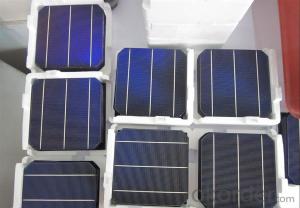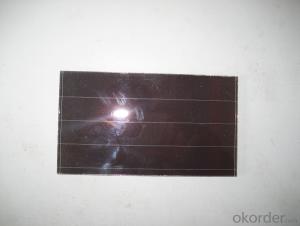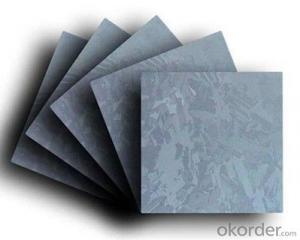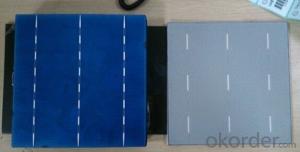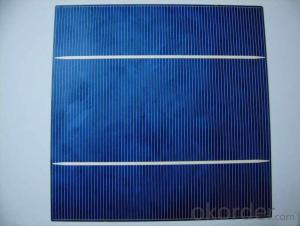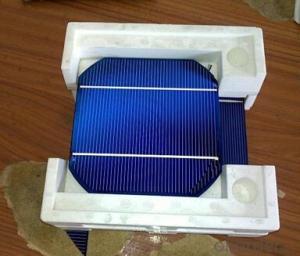High Current Solar Cell 16.8% Polycrystalline Silicon Solar Cell Price
- Loading Port:
- Shanghai
- Payment Terms:
- TT OR LC
- Min Order Qty:
- 1000 pc
- Supply Capability:
- 100000 pc/month
OKorder Service Pledge
OKorder Financial Service
You Might Also Like
4 Bus Bars 156*156 17.6% efficiency poly solar cell
PHYSICAL CHARACTERISTICS
Dimension: 156mm x 156mm ± 0.5mm
Wafer Thickeness: 180um+20um and 200um+20um
Front(-) Four 1.2mm silver busbar
Silicon nitride blue anti-reflection coating
Back(+) aluminum back surface field
1.75mm(silver) wide segment soldering pads
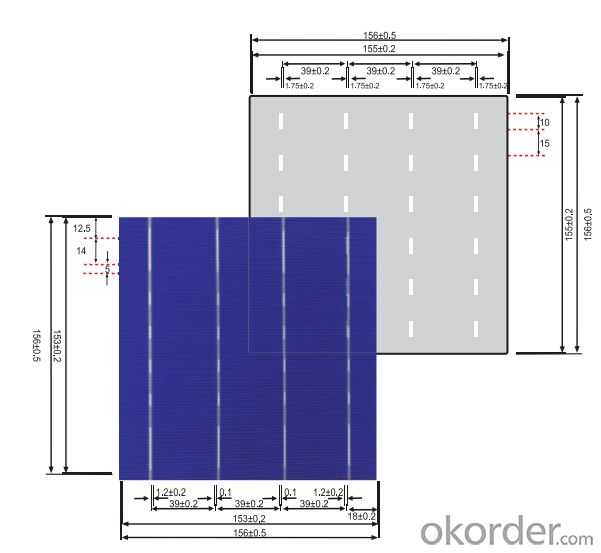
Typical Electrical Characteristics
Efficiency | W(Pmpp) | V(Umpp) | A(Impp) | V(Uoc) | A(Isc) |
17.4-17.5 | 4.234 | 0.517 | 8.231 | 0.622 | 8.759 |
17.5-17.6 | 4.259 | 0.519 | 8.243 | 0.623 | 8.769 |
17.7-17.8 | 4.283 | 0.521 | 8.256 | 0.625 | 8.779 |
17.8-17.9 | 4.307 | 0.523 | 8.268 | 0.626 | 8.788 |
17.9-18.0 | 4.332 | 0.525 | 8.281 | 0.627 | 8.798 |
18.0-18.1 | 4.380 | 0.529 | 8.306 | 0.629 | 8.808 |
18.1-18.2 | 4.405 | 0.531 | 8.318 | 0.632 | 8.818 |
18.2-18.3 | 4.429 | 0.533 | 8.331 | 0.633 | 8.837 |
18.3-18.4 | 4.453 | 0.535 | 8.344 | 0.634 | 8.847 |
18.4-18.5 | 4.478 | 0.537 | 8.356 | 0.636 | 8.856 |
18.5-18.6 | 4.502 | 0.539 | 8.369 | 0.637 | 8.866 |
Efficiency | W(Pmpp) | V(Umpp) | A(Impp) | V(Uoc) | A(Isc) |
20.90-21.00 | 5.06 | 0.557 | 9.007 | 0.653 | 9.688 |
20.80-20.90 | 5.04 | 0.556 | 9.062 | 0.652 | 9.683 |
20.70-20.80 | 5.02 | 0.554 | 9.055 | 0.651 | 9.684 |
20.60-20.70 | 4.99 | 0.552 | 9.033 | 0.651 | 9.672 |
20.50-20.60 | 4.97 | 0.550 | 9.002 | 0.650 | 9.673 |
20.40-20.50 | 4.94 | 0.548 | 9.012 | 0.649 | 9.674 |
20.30-20.40 | 4.92 | 0.546 | 9.009 | 0.649 | 9.655 |
20.20-20.30 | 4.89 | 0.543 | 9.012 | 0.648 | 9.634 |
20.10-20.20 | 4.87 | 0.541 | 8.998 | 0.648 | 9.617 |
20.00-20.10 | 4.85 | 0.540 | 8.977 | 0.647 | 9.600 |
*Data under standard testing conditional (STC):1,000w/m2,AM1.5, 25°C , Pmax:Positive power tolerance.
3 Bus Bars 156*156 17.4% efficiency poly solar cell
Dimension: 156 mm x 156 mm ± 0.5 mm
Wafer Thickeness: 156 mm x 156 mm ± 0.5 mm
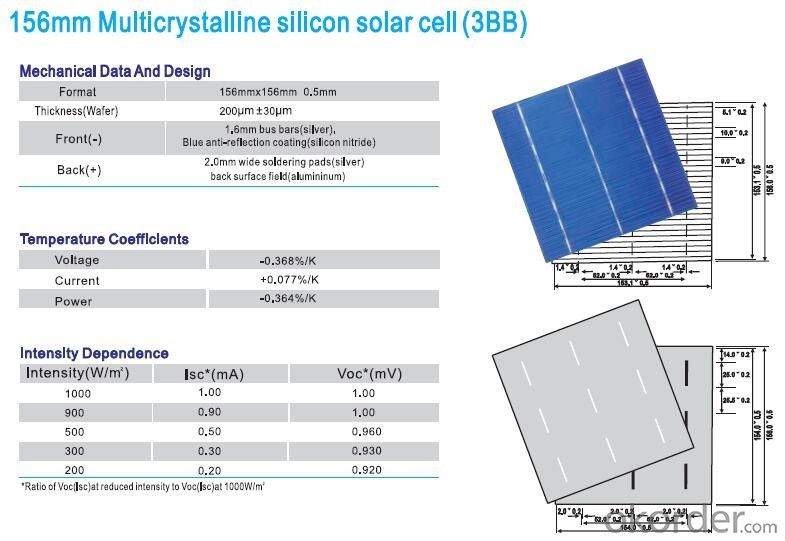
Typical Electrical Characteristics:
| Efficiency code | 1660 | 1680 | 1700 | 1720 | 1740 | 1760 | 1780 | 1800 | 1820 | 1840 | 1860 |
| Efficiency (%) | 16.6 | 16.8 | 17.0 | 17.2 | 17.4 | 17.6 | 17.8 | 18.0 | 18.2 | 18.4 | 18.6 |
| Pmax (W) | 4.04 | 4.09 | 4.14 | 4.19 | 4.23 | 4.28 | 4.33 | 4.38 | 4.43 | 4.48 | 4.53 |
| Voc (V) | 0.612 | 0.615 | 0.618 | 0.621 | 0.624 | 0.627 | 0.629 | 0.63 | 0.633 | 0.635 | 0.637 |
| Isc (A) | 8.42 | 8.46 | 8.51 | 8.56 | 8.61 | 8.65 | 8.69 | 8.73 | 8.77 | 8.81 | 8.84 |
| Imp (A) | 7.91 | 7.99 | 8.08 | 8.16 | 8.22 | 8.27 | 8.33 | 8.38 | 8.43 | 8.48 | 8.53 |
* Testing conditions: 1000 W/m2, AM 1.5, 25 °C, Tolerance: Efficiency ± 0.2% abs., Pmpp ±1.5% rel.
* Imin : at 0.5 V
Production:
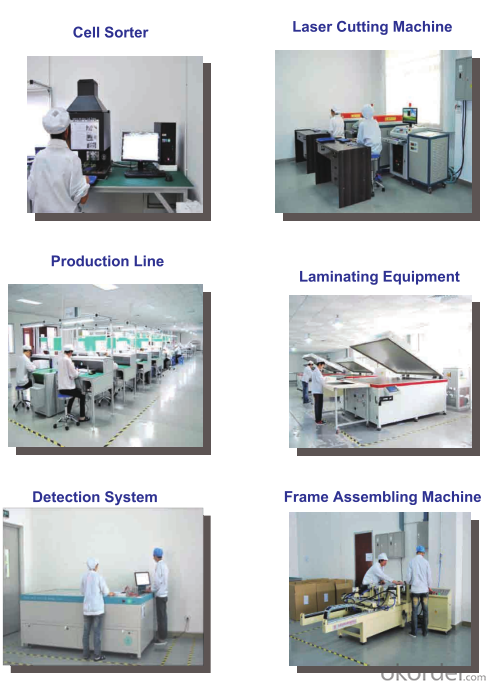
Package:
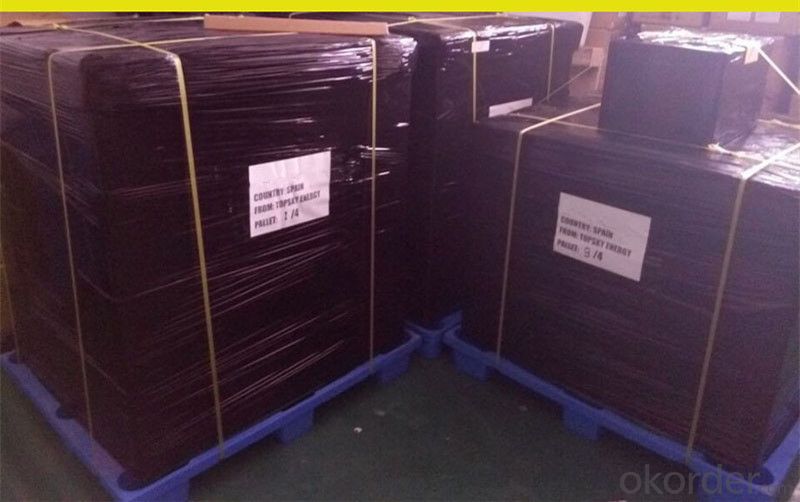
FAQ:
1. Q: Do you have your own factory?
A: Yes, we have. Our factory located in Jiangsu
2. Q: How can I visit your factory?
A: Before you visit,please contact us.We will show you the route or arrange a car to pick you up.
3. Q: Do you provide free sample?
A: Commenly we provide paid sample.
4. Q: Could you print our company LOGO on the nameplate and package?
A: Yes, we accept it.And need an Authorization Letter from you.
5. Q: Do you accept custom design on size?
A: Yes, if the size is reasonable.
6. Q: How can I be your agent in my country?
A: Please leave feedback. It's better for us to talk about details by email.
7. Q: Do you have solar project engineer who can guide me to install system?
A: Yes, we have a professional engineer team. They can teach you how to install a solar system.
- Q:Are there any safety concerns associated with handling solar silicon wafers?
- Yes, there are safety concerns associated with handling solar silicon wafers. Silicon wafers are fragile and can easily break, leading to potential lacerations or puncture injuries. Additionally, the wafers are often coated with various chemicals, such as photoresist or anti-reflective coatings, which may be hazardous if inhaled or ingested. It is essential to follow proper handling procedures, wear appropriate personal protective equipment, and work in a controlled environment to minimize any potential risks.
- Q:How is the quality of a solar silicon wafer measured?
- The quality of a solar silicon wafer is typically measured through various tests and evaluations. These include monitoring the electrical properties such as resistivity and carrier lifetime, as well as assessing the physical characteristics like crystal structure, surface texture, and overall thickness uniformity. Additionally, optical measurements such as reflectivity and transmission are also taken into account. These evaluations help determine the efficiency and performance of the wafer in converting sunlight into electricity, ultimately indicating its quality.
- Q:How do solar silicon wafers contribute to reducing greenhouse gas emissions?
- Solar silicon wafers contribute to reducing greenhouse gas emissions by enabling the production of solar panels, which generate clean and renewable electricity. As silicon wafers are the key component of photovoltaic cells, they absorb sunlight and convert it into usable energy, eliminating the need for fossil fuel-based power generation. By replacing traditional energy sources with solar power, greenhouse gas emissions from power plants and other fossil fuel combustion processes are significantly reduced, consequently mitigating climate change and promoting a more sustainable future.
- Q:After cutting a few chips, mortar density is getting lower and lower
- Iron powder and silica fume more and more, the density should be more and more big, unless it is your water content is higher and higher
- Q:Can solar silicon wafers be used in off-grid lighting systems?
- Yes, solar silicon wafers can be used in off-grid lighting systems. These wafers are the main component of solar panels, which convert sunlight into electricity. By harnessing solar energy, off-grid lighting systems can operate independently from the traditional power grid, making them ideal for remote or unconnected locations.
- Q:What is the role of a passivation layer in a solar silicon wafer?
- The role of a passivation layer in a solar silicon wafer is to reduce surface recombination and improve the efficiency of the solar cell. It acts as a protective coating that prevents unwanted chemical reactions, minimizes surface defects, and enhances the electrical properties of the silicon wafer. This passivation layer helps to increase the overall performance and lifespan of the solar cell.
- Q:How do solar silicon wafers perform in extreme weather conditions?
- Solar silicon wafers are designed to withstand extreme weather conditions effectively. They are typically made from durable materials that can handle temperature variations, such as high heat or freezing cold. Additionally, they are designed to be resistant to moisture, wind, and hail, ensuring their performance remains stable even during storms or extreme weather events. However, it is important to note that extreme weather conditions can still have some impact on the overall efficiency of solar panels, reducing their energy production temporarily.
- Q:How do solar silicon wafers perform in different weather conditions?
- Solar silicon wafers typically perform well in a wide range of weather conditions. However, their efficiency can be affected by certain factors. In sunny conditions, the wafers absorb sunlight and convert it into electricity with high efficiency. In cloudy or overcast weather, they still generate some power, albeit at a lower rate. Rainfall generally does not impact their performance significantly, as the wafers are designed to be waterproof. However, extreme weather events like hailstorms or heavy snowfall can cause physical damage to the wafers, reducing their efficiency or even rendering them inoperable. Overall, solar silicon wafers are designed to withstand various weather conditions and continue to generate electricity, albeit at varying rates depending on the intensity of sunlight.
- Q:What is the effect of temperature on the efficiency of a solar silicon wafer?
- The efficiency of a solar silicon wafer increases as the temperature decreases.
- Q:How do solar silicon wafers perform in sandy environments?
- Solar silicon wafers perform relatively well in sandy environments due to their durability and resistance to dust and sand particles. However, excessive accumulation of sand or dust on the surface of the wafers can reduce their efficiency by blocking sunlight. Regular cleaning and maintenance are therefore necessary to ensure optimal performance in sandy conditions.
1. Manufacturer Overview |
|
|---|---|
| Location | |
| Year Established | |
| Annual Output Value | |
| Main Markets | |
| Company Certifications | |
2. Manufacturer Certificates |
|
|---|---|
| a) Certification Name | |
| Range | |
| Reference | |
| Validity Period | |
3. Manufacturer Capability |
|
|---|---|
| a)Trade Capacity | |
| Nearest Port | |
| Export Percentage | |
| No.of Employees in Trade Department | |
| Language Spoken: | |
| b)Factory Information | |
| Factory Size: | |
| No. of Production Lines | |
| Contract Manufacturing | |
| Product Price Range | |
Send your message to us
High Current Solar Cell 16.8% Polycrystalline Silicon Solar Cell Price
- Loading Port:
- Shanghai
- Payment Terms:
- TT OR LC
- Min Order Qty:
- 1000 pc
- Supply Capability:
- 100000 pc/month
OKorder Service Pledge
OKorder Financial Service
Similar products
New products
Hot products
Hot Searches
Related keywords
